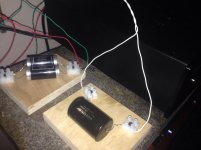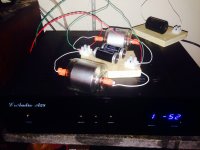I recently received a Lite Audio Ls10 preamp. And need some advice regarding cap value/ tolerances.
Having many caps about from old speaker projects, I decided most would likely be an upgrade to the tiny installed caps; the power supply shunt was a 0.47uF cap. This has been swapped out for a Duelund Alexander, an AudioCap Theta, and a Solen Teflon Supercap .
There were two 0.33uF 630 volt caps connected to two 12AU7's; I swapped these out for some Mundorf Supremes, some Mundorf Silver in Oil, and some Ampohm tinfoil Pio caps, all .33 microfarads.
Surprisingly, to me, the biggest difference maker was the power supply shunt cap, where the green Solen Teflon really lives up to its name , "Supercap".
The lesser change, but still a step above the others, is from the .33uF Ampohms. This is audio, so there's always a "however", and here it is -
The PC board says these should've been 0.22uF , originally.
I do have some AudioCap Theta .22 uF caps, and tried them; the sound is more lifelike with any of the .33 uF caps ( including the factory originals).
Any cause for concern here?
Also, this pre sounds much better with RCA 12AU7's in, and a Sylvania 12B4A , and an Amperex 12BH7 replacing the 12AT7 in the power regulator.
The supplier didn't cheap out here, the unit came with all but one tube from EH.
Having many caps about from old speaker projects, I decided most would likely be an upgrade to the tiny installed caps; the power supply shunt was a 0.47uF cap. This has been swapped out for a Duelund Alexander, an AudioCap Theta, and a Solen Teflon Supercap .
There were two 0.33uF 630 volt caps connected to two 12AU7's; I swapped these out for some Mundorf Supremes, some Mundorf Silver in Oil, and some Ampohm tinfoil Pio caps, all .33 microfarads.
Surprisingly, to me, the biggest difference maker was the power supply shunt cap, where the green Solen Teflon really lives up to its name , "Supercap".
The lesser change, but still a step above the others, is from the .33uF Ampohms. This is audio, so there's always a "however", and here it is -
The PC board says these should've been 0.22uF , originally.
I do have some AudioCap Theta .22 uF caps, and tried them; the sound is more lifelike with any of the .33 uF caps ( including the factory originals).
Any cause for concern here?
Also, this pre sounds much better with RCA 12AU7's in, and a Sylvania 12B4A , and an Amperex 12BH7 replacing the 12AT7 in the power regulator.
The supplier didn't cheap out here, the unit came with all but one tube from EH.
Attachments
Last edited:
A little bigger
Rooting around, I noticed I've still got 4 vacuum caps , from a line level highpass experiment.
200picofarads added to each channel makes an unexpected difference.
A little taller, wider, deeper soundstage, cleaner, more extended treble.
These I found on eBay at different times between $20 and $35 each, delivered.
Maybe not the icing on the cake, but more than the cherry on a sundae!
Will let that Alexander get some hours, then parallel it with my remaining vacuum caps, 300pF in total.
Should've done the power supply shunt first, I guess.
Rooting around, I noticed I've still got 4 vacuum caps , from a line level highpass experiment.
200picofarads added to each channel makes an unexpected difference.
A little taller, wider, deeper soundstage, cleaner, more extended treble.
These I found on eBay at different times between $20 and $35 each, delivered.
Maybe not the icing on the cake, but more than the cherry on a sundae!
Will let that Alexander get some hours, then parallel it with my remaining vacuum caps, 300pF in total.
Should've done the power supply shunt first, I guess.
Attachments
Should've done the power supply shunt first, I guess.
Nop what you should've done first is to buy a handheld LCR meter in the range of 200 to 300$.
Capacitor testing by hearing is far more primitive even than Tarzan when he was moving around in jungle.
He did use branches to jump from a tree to another tree, and therefore the branches is a tool too.
Nop what you should've done first is to buy a handheld LCR meter in the range of 200 to 300$.
Capacitor testing by hearing is far more primitive even than Tarzan when he was moving around in jungle.
He did use branches to jump from a tree to another tree, and therefore the branches is a tool too.
Thanks. Mitchell substitute similar uF cap for old cap.
Mitchell not jump. Mitchell swing on vine.
Bruce's brother, Serious Lee
Actually, Raymond, Lee - owns a local electronics store with his father, Wing. He sold me a nice multimeter 4 years ago, and every year, checks it for calibration.
It only needed re calibrating once after the second year.
The caps marked o.33uF were measured at 0.345uf, and 0.325, the cap marked 0.47uF measured 0.495uF.
The Ampohms measure 0.330 and 0.335uF, as close as I've ever seen matched in a purchase of two pieces.
The Alexander measures 0.500uF,
The Solen Teflon measures 0.475uF.
Other than matching the printed numbers on the factory originals, and meeting or exceeding their DC voltage ratings, this doesn't inform me how they'll sound.
My question pertains more to- ought I use replacement caps similar in uF to what was in the preamplifier, or the values printed on the board.
Thanks for any advice you choose to share.
Actually, Raymond, Lee - owns a local electronics store with his father, Wing. He sold me a nice multimeter 4 years ago, and every year, checks it for calibration.
It only needed re calibrating once after the second year.
The caps marked o.33uF were measured at 0.345uf, and 0.325, the cap marked 0.47uF measured 0.495uF.
The Ampohms measure 0.330 and 0.335uF, as close as I've ever seen matched in a purchase of two pieces.
The Alexander measures 0.500uF,
The Solen Teflon measures 0.475uF.
Other than matching the printed numbers on the factory originals, and meeting or exceeding their DC voltage ratings, this doesn't inform me how they'll sound.
My question pertains more to- ought I use replacement caps similar in uF to what was in the preamplifier, or the values printed on the board.
Thanks for any advice you choose to share.
1) Multimeter s are capable for basic capacity inspection at 5 to 7Hz test frequency, and therefore a multimeter can not test an capacitor inside the Audio frequencies range.
2) Read this topic. http://www.ittsb.eu/forum/index.php?topic=922.0
2) Read this topic. http://www.ittsb.eu/forum/index.php?topic=922.0
the title used in the link is "reforming by DC Volts".
Why do your consider
Why do your consider
DC is zero frequency and no alternating portion of the current.I need to figure the frequency
So... I need to figure the frequency and voltage load the caps are used at, run them in a circuit within those conditions for maybe an hour, and test them after they've settled, (reformed)?
1) AC volts and frequency is what an LCR meter using for the correct measurement of the capacity.
2) Test frequency is set by the capacitor manufacturer.
3) Capacitors (For Tweeters) they should be also tested even as comparison point at 10kHz as verification regarding capacity loss.
By assuming L&R speakers set, both should perform the same at 1kHz and 10kHz.
4) bipolar capacitors (ACV) has and a second specification in DC Volts, if capacity has change for any reason, reforming restore back their capacity value much closer to their written specifications.
5) If the capacitor has fancy labeling but inside is a poor design, an LCR meter and the reforming process will prove if you got scammed or not.
- Status
- This old topic is closed. If you want to reopen this topic, contact a moderator using the "Report Post" button.
- Home
- Source & Line
- Analog Line Level
- A little advice, re capping

